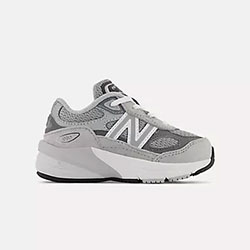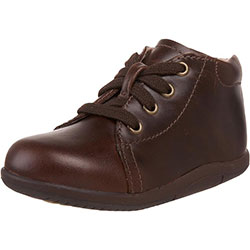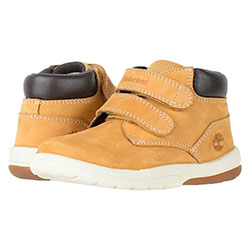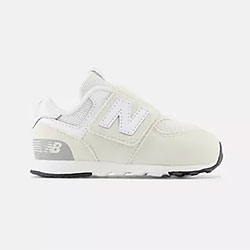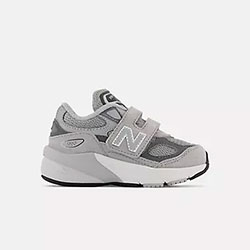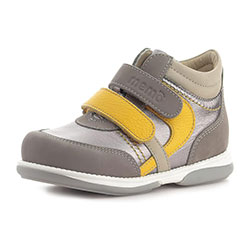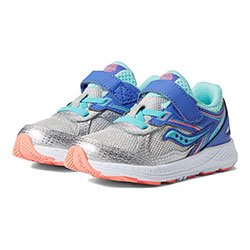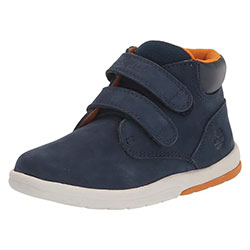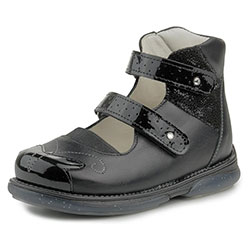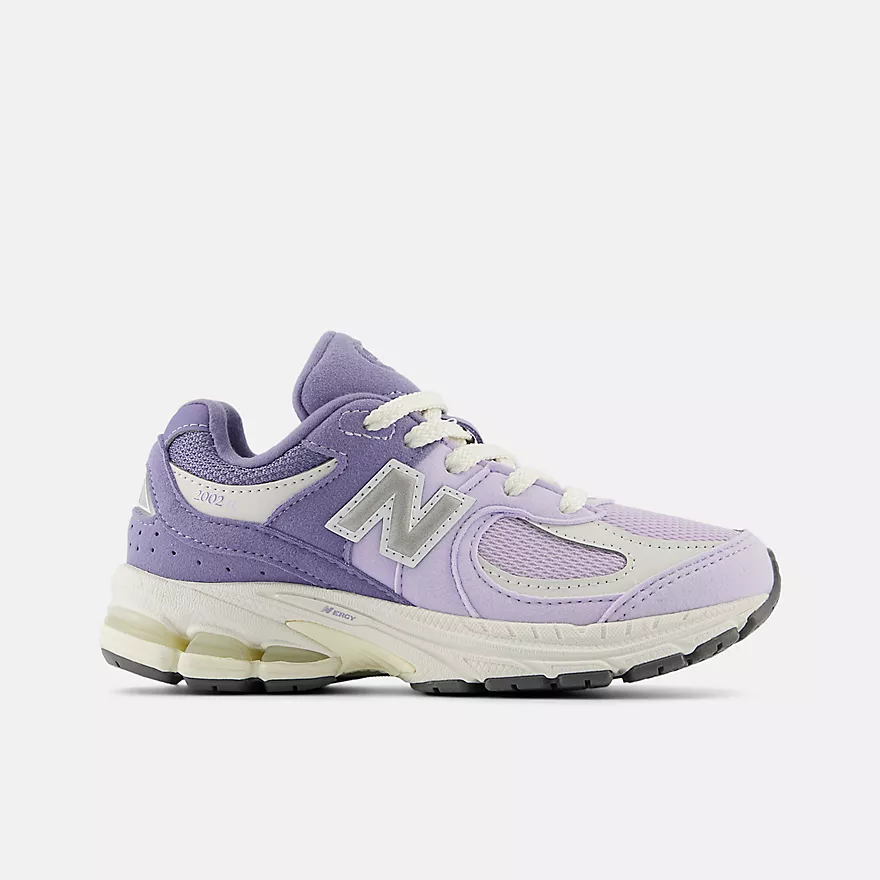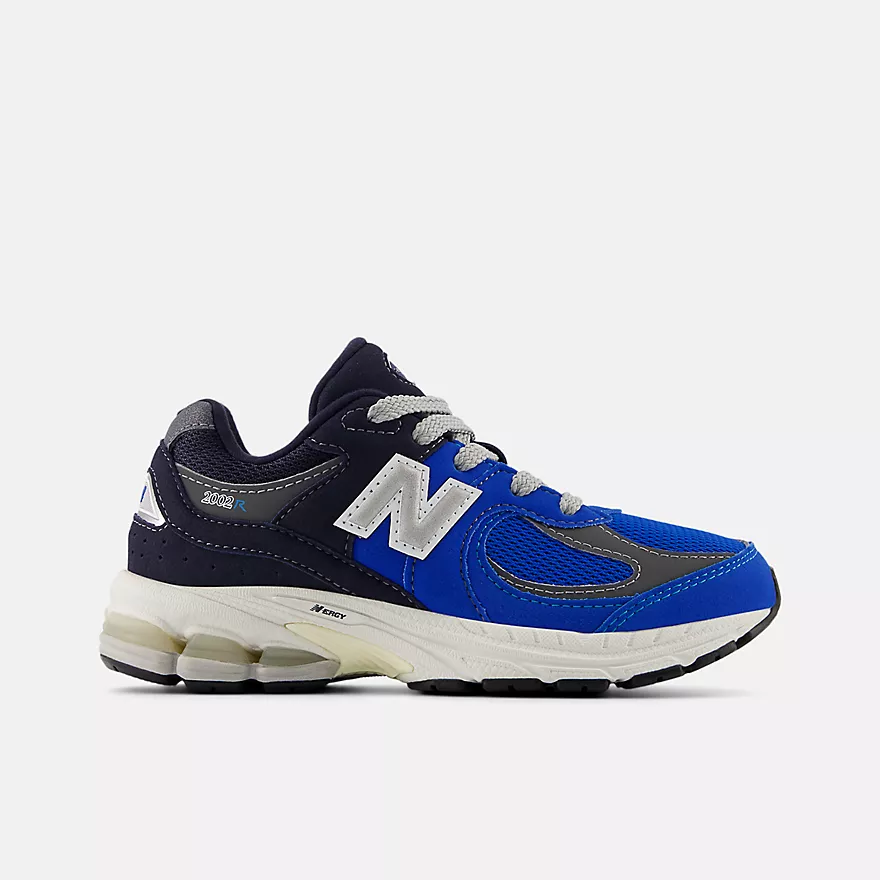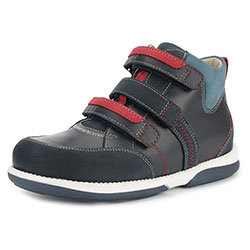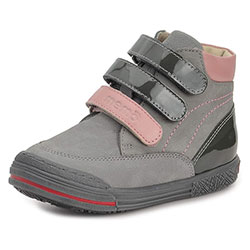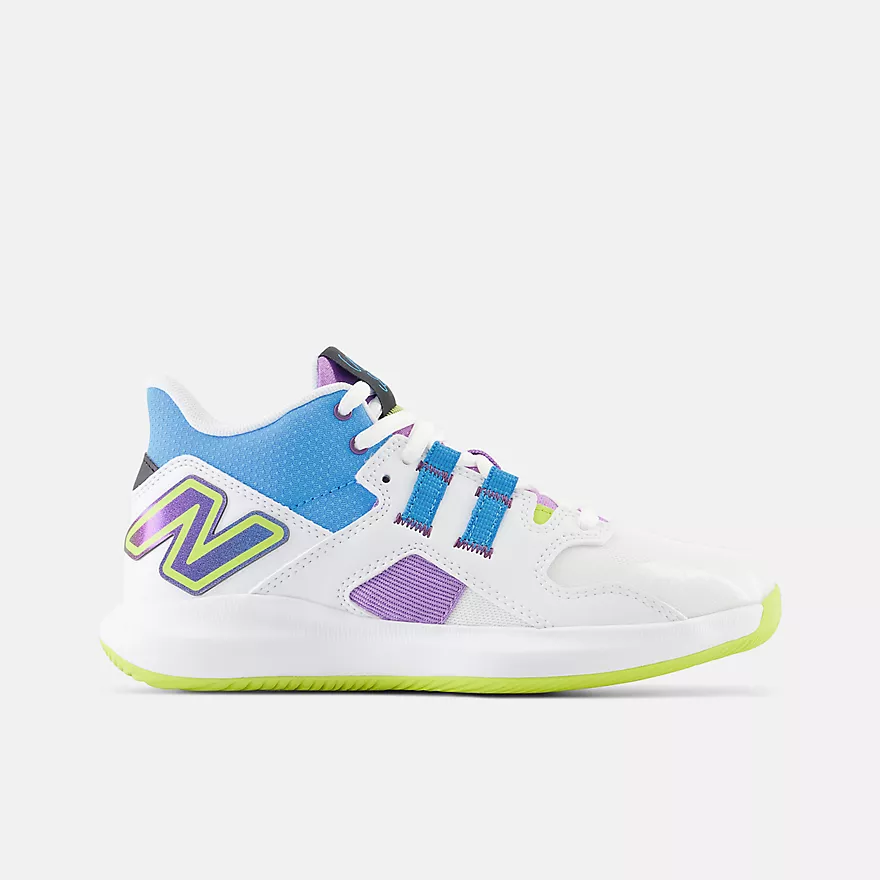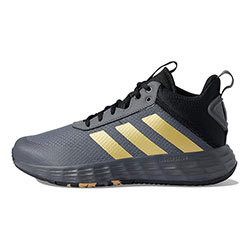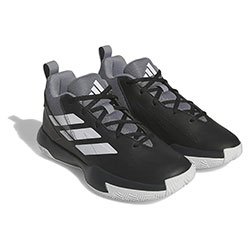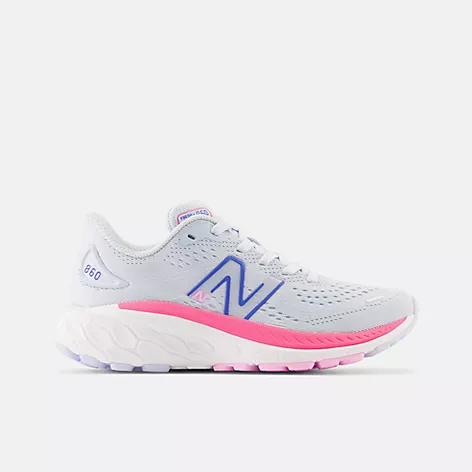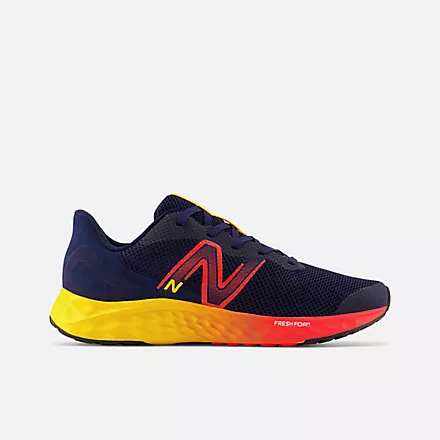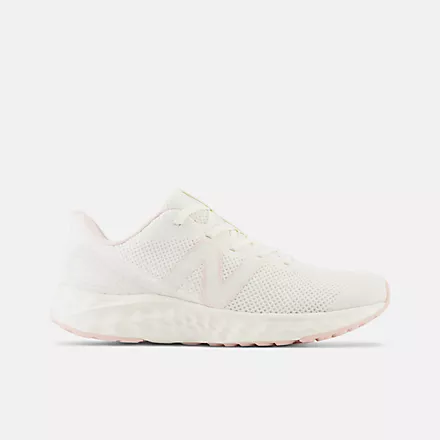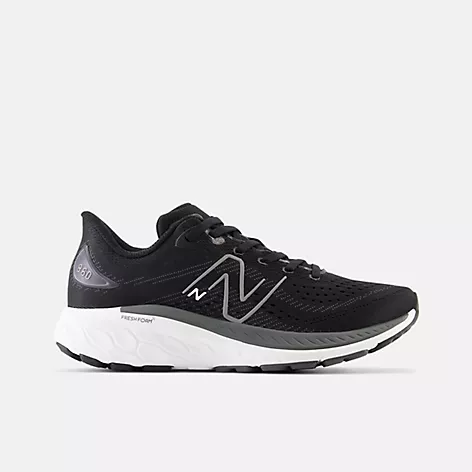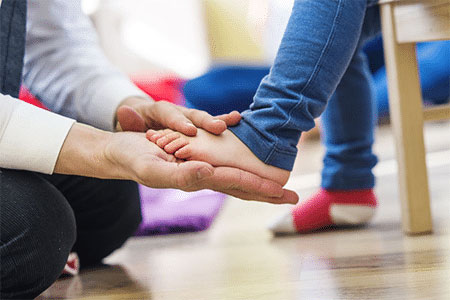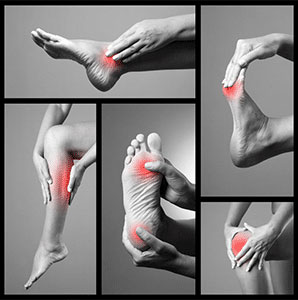The 3 Most Common Reasons Why Children Complain About Foot Pain – Do This Before Going to the Doctor!
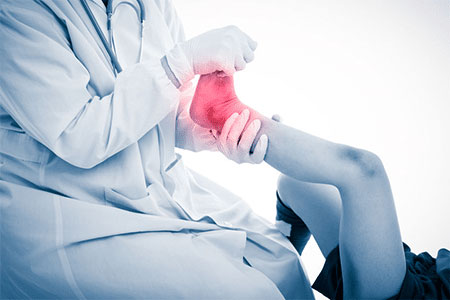
Parents always worry when their children complain about pain, and they should worry, as foot and leg pain is never normal. I always recommend parents to be proactive and don’t take the “wait and see approach” when it comes to dealing with their kids’ foot pain. Let me show you the 3 most common reasons why children complain about foot pain.
Don’t Take the “Wait and See Approach” – Be Proactive!
If your pediatrician told you that your child is just having “growing pains” and will eventually “outgrow them”, let me show you the most effective way to help treat and prevent your child’s foot pain. I don’t know of many parents who are willing to wait around and see if their child’s foot pain will simply “go away.”
I want to emphasize that when it comes to dealing with foot-related problems, early intervention is the key to proper treatment.
These are the 3 most common reasons why children experience foot pain:
1️⃣ Flat Feet
2️⃣ Heel Pain
3️⃣ Low Muscle Tone
Do you know what these 3 foot conditions have in common? They can be treated by simply wearing the correct type of shoes, and depending on the degree of the condition your child might need orthotics as well.
I am going to show you how to identify whether your child has any of these 3 foot conditions and the most effective way to treat them.
1️⃣ Most Common Cause of Foot Pain: Flat Feet
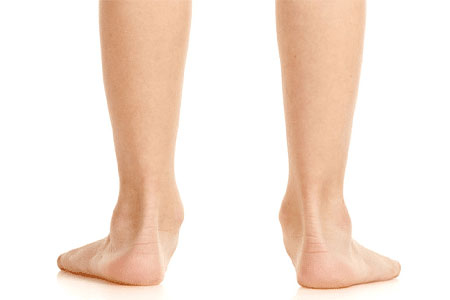
Having flat feet is a hereditary condition that in addition to causing pain, it can directly affect your child’s walking gait and overall posture.
Children with flat feet often complain that their feet hurt and parents really don’t know what caused it because there hasn’t been an injury. Let me show you some examples of children with flat feet:

I have spoken with several parents who after taking their children to a pediatrician they are told that the child is indeed flat footed, but they shouldn’t worry about it because the child might still develop an arch. It is a fact that children can develop arches until they are 5 years old, but why leave this condition untreated when it’s affecting other parts of your child’s body?
Children who are flat footed walk with their feet turned inwards, which shifts their bodies out of alignment and affects their overall posture.
Once the feet are pronated, the knees and hips also become misaligned. When foot posture is not in alignment then your child’s body will have to recruit more muscles for each movement, which leads to an increase in muscle fatigue, tightness and strain.
What Can You Do for a Child with Flat Feet?
The good news is that the correct type of shoes can help prevent your child’s feet from collapsing and allow your child to walk and run straighter. I am not talking about providing your child with orthopedic shoes, just regular everyday sneakers that simply provide better support than others. Let me prove it to you!
Below is an image of a flat-footed child standing barefoot. Do you notice how the child’s feet are collapsing and turning inwards?
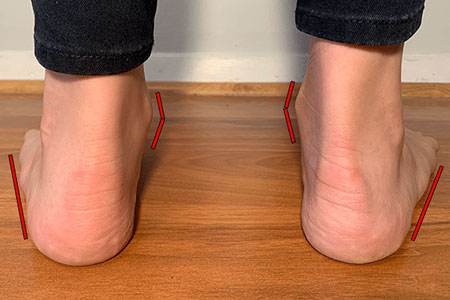
Now let’s take a look at an image of the same child standing in a pair of supportive shoes I recommend. Do you notice how the child’s feet look a lot straighter? The shoes are preventing the child’s feet from collapsing and turning inwards, allowing the child to walk and run straighter.
What a Difference the Correct Type of Shoes Can Make!
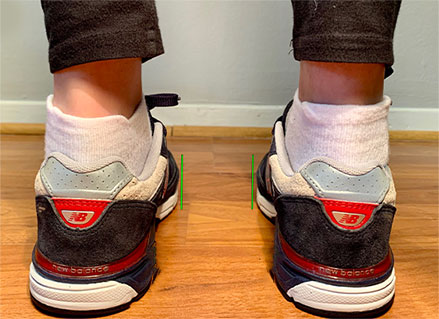
Remember how I mentioned that there is only a small selection of shoes that are supportive enough for a child with flat feet? Let’s see what happens when we fit that same child in a pair of unsupportive shoes:

The feet are collapsing and turning inwards again.
What Makes the Shoes I Recommend Effective for Kids with Flat Feet?
The shoes I recommend come with a substantial outsole that is going to support your child’s feet and prevent them from collapsing. Let me show you the difference in support between one of the shoes I recommend and a different style:
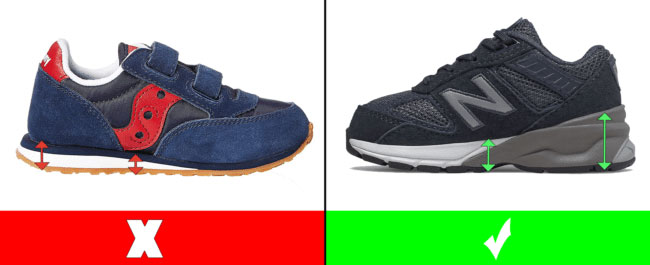
Shoes that come with shoelaces are always better than shoes that come with velcro closure, as shoelaces are going to provide better support and stability to your child.
Can You Correct Flat Feet?
Supportive shoes and orthotics won’t mold your child an arch but will allow your child to live a healthy lifestyle without foot pain.
The correct types of shoes are going to help prevent your child from having to deal with foot and leg pain. Disclosure: Some links in this post may be affiliate links and we may receive a small commission (at no extra cost to you) when you click our links and make purchases.
Best Shoes for Kids with Flat Feet
The shoes below are going to help treat your child’s flat feet by preventing your child’s feet from collapsing and turning inwards. These shoes can fit children with medium (M), wide (W), and extra wide (XW) feet.
- The New Balance shoe style 990V6 is available for toddlers, little, and big kids
- Available in laces and velcro
- Fits children with medium, wide, or extra wide feet
- Suede/mesh upper provides durability and breathability
- Order this shoe half a size larger than your toddler’s current foot size
- The New Balance shoe style 990V6 is available for toddlers, little, and big kids
- Available in laces and velcro
- Fits children with medium, wide, or extra wide feet
- Synthetic/mesh upper provides durability and breathability
- Order this shoe half a size larger than your toddler’s current foot size
- The Stride Rite shoe style Elliot is available for toddlers
- Lace-up closure
- Fits toddlers with medium, wide, or extra wide feet
- 100% leather made
- Order this shoe half a size larger than your toddler’s current foot size
- The Stride Rite shoe style Emilia is available for toddlers
- Lace-up closure
- Fits toddlers with medium, wide, or extra wide feet
- 100% leather made
- Order this shoe a whole size larger than your toddler’s current foot size
- The Timberland shoe style Tracks is available for toddlers
- Double velcro straps
- Fits toddlers with medium or wide feet
- Water-friendly
- Order this shoe a whole size larger than your toddler’s current foot size
- The New Balance shoe style 574 is available for toddlers
- Available in velcro and laces
- Fits children with medium, wide, or extra wide feet
- Synthetic/mesh upper provides durability and breathability
- Order this shoe a whole size larger than your toddler’s current foot size
- The New Balance shoe style 990V6 is available for toddlers, little, and big kids
- Available in velcro and laces
- Fits children with medium, wide, or extra wide feet
- Synthetic/mesh upper provides durability and breathability
- Order this shoe a half size larger than your toddler’s current foot size
- The Memo shoe style Gabi is available for toddlers and little kids
- Double velcro straps
- Fits children with medium or wide feet
- Genuine leather and breathable mesh
- Thermoplastic asymmetric stiff heel counter for proper feet protection and stabilization
- Order this shoe half a size larger than your toddler’s current foot size
- The Memo shoe style Gabi is available for toddlers and little kids
- Double velcro straps
- Fits children with medium or wide feet
- Genuine leather and breathable mesh
- Thermoplastic asymmetric stiff heel counter for proper feet protection and stabilization
- Order this shoe half a size larger than your toddler’s current foot size
- The Saucony shoe style Cohesion is available for toddlers
- Velcro closure
- Fits toddlers with medium or wide feet
- Heel grid system for stable cushioning
- Compression molded EVA footbed for comfort
- Order this shoe a whole size larger than your toddler’s current foot size
- The Timberland shoe style Bootie fits toddlers and little kids
- Double velcro straps
- Fits children with medium or wide feet
- Padded collar for a comfortable fit around the ankle
- Water-friendly
- Order this shoe a whole size larger than your toddler’s current foot size
- The Memo shoe style Princessa fits toddlers and little kids
- Double velcro straps
- Fits children with medium or wide feet
- This is an ORTHOPEDIC shoe
- Rigid heel counter
- Order this shoe half a size larger than your toddler’s current foot size
- The Saucony shoe style Cohesion KDZ is available for little and big kids
- Velcro closure
- Fits children with medium and wide feet
- Heel grid system for stable cushioning
- Compression molded EVA footbed for comfort
- Order this shoe a half size larger than your child’s current foot size
- The Saucony shoe style Cohesion KDZ is available for little and big kids
- Velcro closure
- Fits children with medium and wide feet
- Synthetic and mesh upper
- Heel grid system for stable cushioning
- Order this shoe half a size larger than your child’s current foot size
- The New Balance shoe style Fresh Foam 650 is available for little and big kids
- Fits children with medium, wide, or extra wide feet
- Velcro closure
- ABZORB midsole absorbs impact through a combination of cushioning and compression resistance
- Mesh upper material features no-sew overlays for a sleek fit and feel
- Order this shoe half a size larger than your child’s current foot size
- The New Balance shoe style Fresh Foam Arishi v4 is available for little and big kids
- Fits children with medium, wide, or extra wide feet
- Velcro closure
- ABZORB midsole absorbs impact through a combination of cushioning and compression resistance
- Mesh upper material features no-sew overlays for a sleek fit and feel
- Order this shoe half a size larger than your child’s current foot size
- The New Balance shoe style 2002 is available for toddlers and little kids
- Available in laces
- Fits children with medium and wide feet
- Suede/mesh upper provides durability and breathability
- Order this shoe half a size larger than your toddler’s current foot size
- The New Balance shoe style 2002 is available for toddlers and little kids
- Available in laces
- Fits children with medium and wide feet
- Suede/mesh upper provides durability and breathability
- Order this shoe half a size larger than your toddler’s current foot size
- The New Balance shoe style Fresh Foam 650 is available for little and big kids
- Fits children with medium, wide, or extra wide feet
- Velcro closure
- Synthetic and engineered mesh upper
- Fresh Foam midsole cushioning is precision engineered to deliver an ultra-cushioned, lightweight ride
- Order this shoe a half size larger than your child’s current foot size
- The Memo shoe style Polo is available for little and big kids
- Triple velcro straps
- Fits children with medium or wide feet
- This is an orthopedic shoe
- Thermoplastic rigid heel counter
- Order this shoe a half size larger than your child’s current foot size
- The Memo shoe style Chicago is available for little and big kids
- Triple velcro straps
- Fits children with medium or wide feet
- This is an orthopedic shoe
- Thermoplastic rigid heel counter
- Order this shoe a half size larger than your child’s current foot size
- The New Balance shoe style Coco is available for little and big kids
- Lace-up closure
- Fits children with medium or wide feet
- NDurance rubber outsole technology provides superior durability in high-wear areas to help get more out of the shoes
- Order this shoe a half size larger than your child’s current foot size
- The Adidas shoe style Own the Game 2.0 is available for little and big kids
- Lace-up closure
- Fits children with medium or wide feet
- Supportive outsoles and firm heel counter
- Order this shoe a half size larger than your child’s current foot size
- The Adidas shoe style Cross Em Up Select is available for little kids
- Lace-up closure
- Fits children with medium or wide feet
- Non-marking outsole
- Order this shoe a whole larger than your child’s current foot size
- The Saucony shoe style Kinvara LTT is available for little and big kids
- Lace-up closure
- Fits children with medium or wide feet
- Cushioned footbed
- Order this shoe a whole size larger than your child’s current foot size
- The Saucony shoe style Shadow 6000 is available for little and big kids
- Lace-up closure
- Fits children with medium or wide feet
- Cushioned footbed
- Order this shoe half a size larger than your child’s current foot size
- The New Balance shoe style 574 is available for little and big kids
- Lace-up closure
- Fits children with medium or wide feet
- ENCAP midsole cushioning provides good arch and heel support
- Order this shoe half a size larger than your child’s current foot size
- The New Balance shoe style 327 is available for little and big kids
- Lace-up closure
- Fits children with medium or wide feet
- Suede and mesh upper
- Order this shoe a whole size larger than your child’s current foot size
- The New Balance shoe style Fresh Foam X 1080v13 is available for big kids
- Lace-up closure
- Fits children with medium or wide feet
- Suede and mesh upper
- Order this shoe half a size larger than your child’s current foot size
- The New Balance shoe style Fresh Foam X 1080v13 is available for big kids
- Lace-up closure
- Fits children with medium or wide feet
- Suede and mesh upper
- Order this shoe half a size larger than your child’s current foot size
It’s important that you fit your child’s shoes correctly. This means that the shoes can’t be too small or too large.
How to Retrieve Your Child’s Exact Foot Length and Shape
If you are unsure about what shoe size your child should wear I suggest that you take a look at a different resource I created.
Let’s say you try the shoes I recommend and after 3 months of wearing them, your child’s walking doesn’t improve. In this case, your child might need an orthotic to be fitted inside the shoes for extra support.
2️⃣ Second Most Common Cause of Foot Pain: Heel Pain
Severs disease is the most common cause of heel pain in children and is an inflammation of the heel’s growth plate due to muscle strain and repetitive stress. This condition happens to children between the ages of 8 and 15 years old.
Heel pain problems are often associated with these signs:
- Pain in the back or bottom of the heel.
- Limping.
- Walking on toes.
- Difficulty participating in high-impact activities or sports.
Most pediatricians will tell you how to help treat your child’s heel pain your child will have to reduce or stop the activity. This means that the child might have to sit out from playing sports or being involved in activities for up to 2 months. For most children, this is simply not an option.
How Do You Treat Severs Disease?
I recommend wearing shoes to help cushion the heel. Certain shoes are extremely effective in softening the impact on the heel when walking, running, and standing.
Let me help you visualize the difference in heel support between one of the shoes I recommend a different style. Do you notice how the shoe on the right has a lot more padding below the heel compared to the shoe on the left?
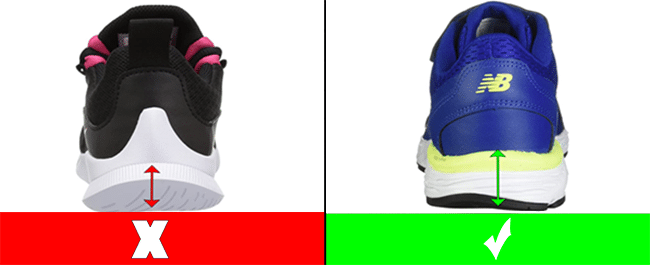
To help treat and prevent your child’s heel pain, your child’s shoes must provide a firm heel counter. The heel counter is the back part of the shoes that provides heel support.
Take a look at the difference between a shoe with a firm heel counter and a shoe with a softer one:

Best Shoes for Kids with Heel Pain
The shoes below are going to help treat your child’s heel pain by supporting and reducing the impact on your child’s heels. These shoes can fit children with medium (M), wide (W), and extra wide (XW) feet.
Little Kid Shoe Sizes (10.5 to 3)
- Shoe style Fresh Foam X 860v13
- Available in medium and wide widths
- Lace-up closure
- Fresh Foam midsole cushioning is precision engineered to deliver an ultra-cushioned, lightweight ride
- Ultra Heel design hugs the back of the foot for a snug, supportive fit
- Order this shoe half a size larger than your child’s current foot size
- Shoe style RaveRun by New Balance
- Available in medium, wide, and extra wide widths
- Lace-up closure
- Fresh Foam midsole cushioning is precision engineered to deliver an ultra-cushioned, lightweight ride
- Ultra Heel design hugs the back of the foot for a snug, supportive fit
- Order this shoe half a size larger than your child’s current foot size
- Shoe style Axon by Saucony
- Available in medium and wide widths
- EVA midsole provides increased shock attenuation, responsive cushioning and lasting durability
- Cushioned footbed
- Order this shoe a whole size larger than your child’s current foot size
- Shoe style Axon by Saucony
- Available in medium and wide widths
- EVA midsole provides increased shock attenuation, responsive cushioning and lasting durability
- Padded tongue and collar
- Cushioned footbed
- Order this shoe a whole size larger than your child’s current foot size
- Shoe style Fresh Foam X 860 V13 by New Balance
- Available in medium and wide widths
- Lace-up closure
- Dual-layer midsole construction featuring top-bed foam cushioning and underfoot Fresh Foam X
- Order this shoe half a size larger than your child’s current foot size
- Shoe style Fresh Foam X 860 V13 by New Balance
- Available in medium and wide widths
- Lace-up closure
- Fresh Foam midsole cushioning is precision engineered to deliver an ultra-cushioned, lightweight ride
- Order this shoe half a size larger than your child’s current foot size
- Shoe style RaveRun by New Balance
- Available in medium, wide, and extra wide widths (fits high insteps)
- Lace-up closure
- Dual-layer midsole construction featuring top-bed foam cushioning and underfoot Fresh Foam X
- Order this shoe half a size larger than your child’s current foot size
- Shoe style Fresh Foam X 860v13 by New Balance
- Available in medium and wide widths
- Lace-up closure
- Strong rubber outsole and cushioned midsoles
- Order this shoe half a size larger than your child’s current foot size
- Shoe style TR14 LTT by Saucony
- Available in medium and wide widths
- Lace-up closure
- Foam padding placed around your ankle collar and under the tongue for an incredibly comfortable fit and feel
- Comfort sockliner molds to your foot with padding in the heel for ultimate cushioning at heel-strike
- Engineered mesh for structure, stretch and enhanced breathability
- Order this shoe half a size larger than your child’s current foot size
- Shoe style Cohesion TR14 LTT by Saucony
- Available in medium and wide widths
- Lace-up closure
- Foam padding placed around your ankle collar and under the tongue for an incredibly comfortable fit and feel
- Comfort sockliner molds to your foot with padding in the heel for ultimate cushioning at heel-strike
- Engineered mesh for structure, stretch and enhanced breathability
- Order this shoe half a size larger than your child’s current foot size
Big Kid Shoe Sizes (3.5 to 7)
- Shoe style Fresh Foam Arishi by New Balance
- Available in medium and wide widths
- Lace-up closure
- Fresh Foam midsole cushioning is precision engineered to deliver an ultra-cushioned, lightweight ride
- Ultra Heel design hugs the back of the foot for a snug, supportive fit
- Order this shoe half a size larger than your child’s current foot size
- Shoe style Fresh Foam Arishi v4 by New Balance
- Available in medium, wide, and extra wide widths
- Lace-up closure
- Fresh Foam midsole cushioning is precision engineered to deliver an ultra-cushioned, lightweight ride
- Ultra Heel design hugs the back of the foot for a snug, supportive fit
- Order this shoe half a size larger than your child’s current foot size
- Shoe style Kinvara by Saucony
- Available in medium and wide widths
- EVA midsole provides increased shock attenuation, responsive cushioning and lasting durability
- Padded tongue and collar
- Cushioned footbed
- Order this shoe a whole size larger than your child’s current foot size
- Shoe style Kinvara by Saucony
- Available in medium and wide widths
- Foam padding placed around your ankle collar and under the tongue for an incredibly comfortable fit and feel
- Comfort sockliner molds to your foot with padding in the heel for ultimate cushioning at heel-strike
- Engineered mesh for structure, stretch and enhanced breathability
- Order this shoe half a size larger than your child’s foot size
- Shoe style RaveRun by New Balance
- Available in medium, wide, and extra wide widths (fits high insteps)
- Lace-up closure
- Dual-layer midsole construction featuring top-bed foam cushioning and underfoot Fresh Foam X
- Order this shoe half a size larger than your child’s current foot size
- Shoe style RaveRun by New Balance
- Available in medium, wide, and extra wide widths
- Lace-up closure
- Fresh Foam midsole cushioning is precision engineered to deliver an ultra-cushioned, lightweight ride
- Ultra Heel design hugs the back of the foot for a snug, supportive fit
- Order this shoe half a size larger than your child’s current foot size
- Shoe style Fresh Foam X 880v12 by New Balance
- Available in medium and wide widths (fits high insteps)
- Lightweight EVA foam cushioning in the midsole and padded heel increases comfort
- Firm heel counter
- Supportive heel for active kids
- Breathable mesh upper
- Order this shoe a whole size larger than your child’s current foot size
- Shoe style FuelCell Propel v5 by New Balance
- Available in medium and wide widths (fits high insteps)
- Lace-up closure
- Dual-layer midsole construction featuring top-bed foam cushioning and underfoot Fresh Foam X
- Order this shoe a whole size larger than your child’s current foot size
- Shoe style Kinvara 14 by Saucony
- Available in medium and wide widths
- Lace-up closure
- Lightweight mesh upper
- Fresh Foam midsole cushioning is precision engineered to deliver an ultra-cushioned, lightweight ride
- Order this shoe half a size larger than your child’s current foot size
- Shoe style Arishi Fresh Foam by New Balance
- Available in medium, wide, and extra wide widths (fits high insteps)
- Fresh Foam midsole cushioning is precision engineered to deliver an ultra-cushioned, lightweight ride
- Lightweight mesh upper
- Order this shoe a whole size larger than your child’s current foot size
- Shoe style Axon by Saucony
- Available in medium and wide widths
- EVA midsole provides increased shock attenuation, responsive cushioning and lasting durability
- Cushioned footbed
- Order this shoe a whole size larger than your child’s current foot size
There is a specific heel cup that has proven to be the most effective one when it comes to treating your child’s heel pain.
3️⃣ Third Most Common Cause of Foot Pain: Unsupportive Shoes
Wearing unsupportive shoes or the wrong shoe size are a direct cause of foot pain.
Children who wear poorly made shoes are at an increased risk of developing foot and leg pain. This doesn’t mean that you have to pay more for your kids’ shoes. More expensive shoes don’t automatically translate into better shoes for your child. You just need to know which shoes provide better support than others.
In addition to providing good support, your kids’ shoes must be the correct shoe size. Shoes that are too small will cramp your kids’ toes together and make them rub or overlap against one another. On the other hand, shoes that are too large will allow for too much foot movement inside the shoes and that constant friction and rubbing between the feet and the shoes might lead to foot pain. Your kids’ shoes must fit just right!
Children’s feet come in all different shapes and sizes. Some children have extra narrow feet while others have extra wide feet. Even children with standard feet might have high insteps, which makes it a lot harder to find shoes that fit.
Are Any Other Shoe Choices Available?
Do not hesitate to contact me directly if you are having trouble finding a good pair of shoes for your child:
Is your child dealing with foot pain? Have you found a particular shoe style that has been effective in treating your child’s foot pain?

